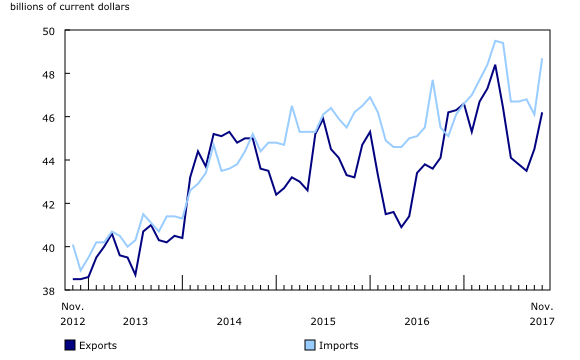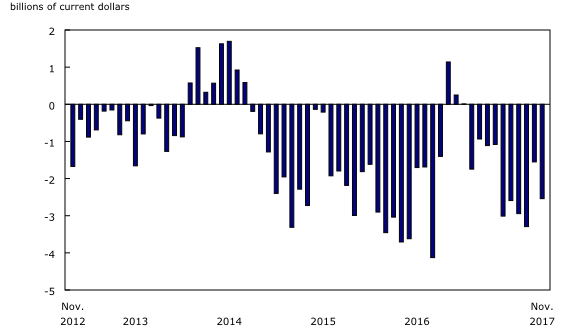Canadian international merchandise trade, November 2017
Archived Content
Information identified as archived is provided for reference, research or recordkeeping purposes. It is not subject to the Government of Canada Web Standards and has not been altered or updated since it was archived. Please "contact us" to request a format other than those available.
Released: 2018-01-05
Canada's merchandise trade deficit with the world totalled $2.5 billion in November, widening from a $1.6 billion deficit in October. Imports were up 5.8% and exports rose 3.7%, both due largely to increased activity in the automotive industry.
Widespread increases in imports
Total imports rose 5.8% to $48.7 billion in November, the strongest increase since July 2009. Increases were observed in 10 of 11 sections. Volumes rose 5.0% and prices were up 0.7%. Imports of electronic and electrical equipment and parts, motor vehicles and parts, as well as aircraft and other transportation equipment and parts contributed the most to the growth in November. Year over year, total imports were up 8.1%.
Imports of electronic and electrical equipment and parts rose 10.9% to $5.8 billion in November, driven by increases in all commodity groups. Communications and audio and video equipment, mainly cell phones, posted a 21.6% gain to a record high $2.1 billion. The introduction of new cell phone models, which is atypical for this time of year, was behind the growth observed in November.
Also contributing to the increase were imports of motor vehicles and parts, which rose 5.4% to $9.2 billion. After two consecutive monthly decreases, imports of motor vehicle engines and motor vehicle parts were up 15.7% in November, returning to August levels. Activity in the automotive industry rebounded in November following the planned shutdowns and work stoppages that occurred in September and October.
Imports of aircraft and other transportation equipment and parts also rose in November, up 18.7% to $2.2 billion. Higher imports of ships from South Korea and China were responsible for the increase.
Higher exports driven by passenger cars and light trucks
Total exports rose 3.7% to $46.2 billion in November, with increases observed in 8 of 11 sections. Higher exports of motor vehicles and parts and consumer goods contributed the most to the growth. Overall, prices were up 3.2%, while volumes increased 0.6%. However, excluding exports of motor vehicles and parts, export volumes were down 1.4%.
The export value of motor vehicles and parts increased 14.6% to $7.7 billion in November. Following a decrease of $1.7 billion over four months, exports of passenger cars and light trucks rebounded 21.2% to $5.3 billion in November. As with imports of motor vehicle engines and motor vehicle parts, increased activity in the automotive industry led to a rise in exports. For the section as a whole, volumes rose 13.4%.
Exports of consumer goods also contributed to the growth in November, rising 7.4% to $6.0 billion. Pharmaceutical and medicinal products (+23.7%) posted the strongest increase, due mainly to increased exports to Italy.
Increase in trade with the United States
Imports from the United States rose 6.5% to $31.9 billion in November. Exports to the United States were up 5.4% to $35.2 billion, led by passenger cars and light trucks. As a result, Canada's trade surplus with the United States decreased from $3.5 billion in October to $3.3 billion in November. Comparing November's average exchange rate to October's, the Canadian dollar lost one US cent relative to the American dollar.
Imports from countries other than the United States increased 4.4% to $16.9 billion in November, mainly on higher imports from China (cell phones), Japan (passenger cars and light trucks) and Saudi Arabia (crude oil).
Exports to countries other than the United States fell 1.4% to $11.0 billion, due to lower exports to the United Kingdom (unwrought gold), South Korea (copper ores) and Mexico (canola). These declines were partially offset by higher exports to China (wood pulp).
As a result, Canada's trade deficit with countries other than the United States widened from $5.0 billion in October to $5.9 billion in November.
Sharp increase in real imports
In real (or volume) terms, imports rose 5.0% in November, following a 3.8% decline in October. Real exports were up 0.6%, due mainly to an increase observed in motor vehicles and parts.
Revisions to October exports and imports
Revisions reflected initial estimates being updated with or replaced by administrative and survey data as they became available, as well as amendments made for late documentation of high-value transactions. Exports in October, originally reported as $44.5 billion in last month's release, were essentially unchanged in the current month's release. October imports, originally reported as $45.9 billion in last month's release, were revised to $46.1 billion.
Note to readers
Merchandise trade is one component of Canada's international balance of payments (BOP), which also includes trade in services, investment income, current transfers and capital and financial flows.
International trade data by commodity are available on both a BOP and a customs basis. International trade data by country are available on a customs basis for all countries and on a BOP basis for Canada's 27 principal trading partners (PTPs). The list of PTPs is based on their annual share of total merchandise trade—imports and exports—with Canada in 2012. BOP data are derived from customs data by making adjustments for factors such as valuation, coverage, timing and residency. These adjustments are made to conform to the concepts and definitions of the Canadian System of National Accounts.
For a conceptual analysis of BOP versus customs-based data, see "Balance of Payments trade in goods at Statistics Canada: Expanding geographic detail to 27 principal trading partners."
For more information on these and other macroeconomic concepts, see the Methodological Guide: Canadian System of Macroeconomic Accounts (13-607-X) and User Guide: Canadian System of Macroeconomic Accounts (13-606-G).
Data in this release are on a BOP basis, seasonally adjusted and in current dollars. Constant dollars are calculated using the Laspeyres volume formula (2007=100).
For information on seasonal adjustment, see Seasonally adjusted data – Frequently asked questions.
Revisions
In general, merchandise trade data are revised on an ongoing basis for each month of the current year. Current-year revisions are reflected in both the customs and BOP-based data.
The previous year's customs data are revised with the release of the January and February reference months, and then on a quarterly basis. The previous two years of customs-based data are revised annually and revisions are released in February with the December reference month.
The previous year's BOP-based data are revised with the release of the January, February, March and April reference months. To remain consistent with the Canadian System of Macroeconomic Accounts, revisions to BOP-based data for previous years are released annually in December with the October reference month.
Factors influencing revisions include the late receipt of import and export documentation, incorrect information on customs forms, replacement of estimates produced for the energy section with actual figures, changes in classification of merchandise based on more current information, and changes to seasonal adjustment factors.
For information on data revisions for crude oil and natural gas, see "Revisions to trade data for crude oil and natural gas."
Revised data are available in the appropriate CANSIM tables.
Real-time CANSIM tables
Real-time CANSIM table 228-8059 will be updated on January 15, 2018. For more information, consult the document Real-time CANSIM tables.
Next release
Data on Canadian international merchandise trade for December 2017 will be released on February 6, 2018.
Products
Customs based data are now available in the Canadian International Merchandise Trade Database (65F0013X).
The updated Canada and the World Statistics Hub – United States (13-609-X) is now available from the home page of our website. This new product illustrates the nature and the extent of Canada's economic and financial relationship with the United States using interactive graphs and tables. This product provides an easy access to information on trade, investment, employment and travel, including merchandise trade by Canadian provinces and US states.
Contact information
For more information, contact us (toll-free 1-800-263-1136; 514-283-8300; STATCAN.infostats-infostats.STATCAN@canada.ca).
To enquire about the concepts, methods or data quality of this release, contact Chris Maloney at 613-790-7158(chris.maloney@canada.ca), or Sandra Mutimukeye at 613-790-3504 (sandra.mutimukeye@canada.ca), International Accounts and Trade Division.
- Date modified:




